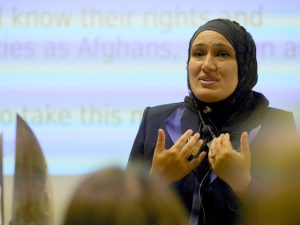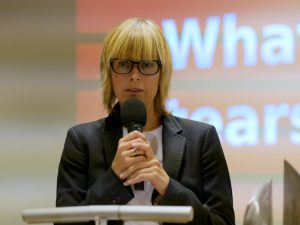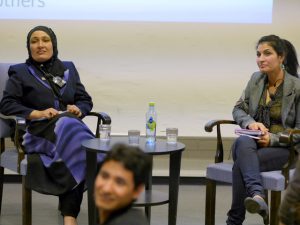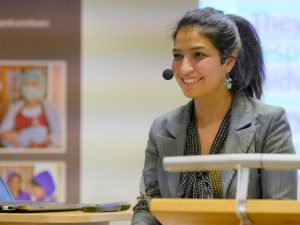
Dr. Khadija drew a large audience on Wednesday night, when she took to the stage at the NCPD to talk about her work educating midwives in Afghanistan.
Norunn Grande welcomed those present and reminded them of the uncertain situation in Afghanistan these days.
– This is the first time in Afghanistan that a president is exchanged for another by an election, Grande said.
Liv Kjølseth introduced the Norwegian Afghanistan Committee (NAC), which have 300 employees in Afghanistan, almost all of them Afghans. Their work is concentrated in rural areas. There are three employees in Norway.
 – Giving birth has always been a risk in Afghanistan, especially in the rural areas where more than 80% of the population lives. Men and boys are prioritised when food is short, and the women are often malnourished. This leads to further complications when giving birth.
– Giving birth has always been a risk in Afghanistan, especially in the rural areas where more than 80% of the population lives. Men and boys are prioritised when food is short, and the women are often malnourished. This leads to further complications when giving birth.
The NAC has been working to improve women’s health conditions since the 1980’s. There are now 3500 registered midwives in Afghanistan. 40% of Afghan women are given qualified help when giving birth. Still, one in 35 will die from complications. Educating midwives has been the most effective way of reducing the mortality rates among women and children. 240 have been educated from the Midwifery School in Jalalabad, which is supported by Norwegian donors.
One of few with access to education
Dr. Khadija had called her presentation “What Are Tears?”
She started by appealing to the politicians of her country to solve problems peacefully. She then moved on to the differences between Afghan Law, Islam and Afghan culture.
– What is Islam? What is culture? In Afghanistan, the rule of culture is so strong, we could never implement the rule of law or the rule of Islam. They both state that women should be allowed to study. The culture maintains that women should stay in the homes all their lives. There is no place for work.
Dr. Khadija showed several Afghan cultural traits that are in conflict with with Afghan law and Islam. She brought up the various customs of intermarriage between families, that sometimes have grave consequences for women who are being married as part of negotiations between families. She also said that Afghanistan is strongly affected by the wars, resulting in changes in culture and society.
To love Afghanistan

Dr. Khadija added women’s rights as an extracurricular part of the midwifery education. But the stakeholders would not accept that until she included Islam in the title. She also included peaceful conflict resolution as a subject.
– We want the students to love Afghanistan. During the fights, many people have lost hope. But we need hope to move on. We want our students to have hope that peace is possible, Dr. Khadija said.
Human rights, women’s rights

Deeva Biabani is a Norwegian Afghan midwife who wrote her dissertation on children mortality rates in Afghanistan. She recounted the difficult conditions under which Afghan midwives work. Being a midwife is one of very few options for an Afghan woman to hold a job, resulting in good recruitment to the education.
– During the education, th a ey will become more conscious on their rights as humans, women and Muslims. They also know all the cultural codes and are able to move relatively freely in the society. They have a unique access to the families and local communities in Afghanistan. Still, the women cannot move around without a man.
Norunn Grande elaborated on the Midwives for Peace project, an idea hatched by Liv Kjølseth and herself.
– I was not aware of the important role the midwives can have in a peace process. Everybody needs the service of a midwife. They need to communicate. They must negotiate security every day. What we did in Kabul this spring was to bring midwives from five districts to Kabul to share their stories with each other.
Dr. Khadija closed by thanking the audience for giving her hope:
– I am so glad to see all of you here, because I know now that I am not alone. I will bring this message to the women of Afghanistan – that they are not alone either.